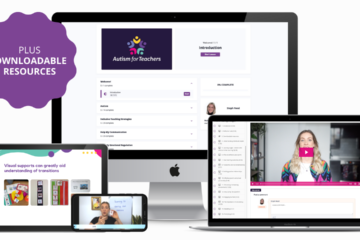Table of Contents
After I completed the ‘Attention Autism’ training last year, adopting the approach in my class has made a HUGE impact on the children’s attention and interaction levels, the staff teams skills in working as a group, and most importantly, it has been a whole lot of fun for everyone!
Attention Autism is a highly motivating and creative approach to building attention and early communication skills and I highly recommend any parent, carer, family member or anyone working with children with autism, to learn more about Attention Autism.

Attention Autism
‘Attention Autism’ was developed by specialist speech and language therapist, Gina Davies.
The approach is based on:
An understanding of the ‘typical’ attention levels and development of infants
This enables us to think about where the child is at with their attention and communication development and what to work on next.
The common strengths of autism
We know that autistic individuals are often visual learners and have good visual skills, therefore, we should use visuals and pictures to share a message, reduce anxiety and add structure. We must also ensure we demonstrate an activity first, as well as modelling how to take part in an activity. This aids the children’s understanding of what they need to do.
The characteristics of autism
Including social communication, interaction, thought and sensory processing differences.
The knowledge that successful communication is dynamic, motivating and fun!
As Gina says, we must “offer an irresistible invitation to learn”.
The Attention Autism activity structure is divided into 4 parts:

Stage 1: Attention bucket
The aims of the bucket session are to:
- Focus attention on the leading adult and their agenda
- Engage attention with enthusiasm
- Enjoy the session!
Items needed:
- Highly engaging toys and items that the children will (hopefully!) enjoy looking at (further information on bucket resources here)
- A bucket with lid, to put the toys and items in
- A pen and whiteboard for you to draw pictorial information to show the children what the next activity is
Session Notes:
The session is begun by drawing a picture of the next activity on the whiteboard and introducing this to the group. Drawing the activity as well as saying it can aid a clearer understanding of the next task. I often find the children are really focused when I’m drawing as they want to know what is coming next!
After the pictures have been introduced, a song about the bucket can follow as another familiar prompt to start the session. Gina’s ‘I’ve got something in my bucket’ features in the video!
The leading adult then takes 1 object at a time from the bucket and models or plays with it in an enthusiastic and engaging way.
The leading adult can then model key words related to the toy or object. These key words can be then reinforced by the supporting adults and then, hopefully the children!
The aim is for it to be so motivating that the children watch. This is important in order for the children to develop their focus and attention on the leading adult.
The supporting adults role is to model engagement and enthusiasm, as well as key words and language, and to ensure the children observe and not touch. If a child comes to take the item, the item can be put back in the bucket and the lid on. The supporting adult can direct the child back to their seat.
Some of the most favourite bucket toys for my class this year have been a rolling and laughing dog, a dancing pumpkin, the blowing ball, the long wizzee balloons, any wind up toys and a woopie cushion!
Comments from Attention Autism creator, Gina Davies
It’s a great privilege to be asked to contribute to this blog. It is easy to run training such as the Attention Autism Programme and give advice but it is putting the new strategies into action that requires courage and resilience. Here is a fabulous example. I love the enthusiasm and engagement Steph is modelling. She is truly offering an irresistible invitation to learn and the students are learning how to focus their attention and tolerate the adult led agenda at the same time. Steph makes it look easy but she is working as a part of a team with her support staff and this takes practice for everyone including the students. It is not about bribing the children to take part with promises of first this then a reward or obliging compliance, it is about creating curiosity and joy in shared good times that are packed with learning opportunities. It is a pleasure to see the work in action.

Gina
Find more information about Attention Autism training and Gina Davies at:




2 Comments
michele coulter · November 21, 2016 at 9:56 pm
I am currently involved in training in Attention Autism and am finding it absolutely inspiring and effective with both staff and children.
Carly · December 1, 2016 at 4:36 am
Very cool! I stumbled across this approach a few days ago, but I live in California and do not have access to her training. I work as an SLP primarily with kiddos with Autism (K-6). Some of my older kiddos still need lots of support in the pre-communication areas, and I think this approach would be very beneficial. Would you mind outlining what a session might look like implementing all four stages? Are they done across several sessions or are all four parts used in each session. If so, what might one of your sessions look like (materials and activities used) and what goals are you targeting. Thanks so much!
Comments are closed.